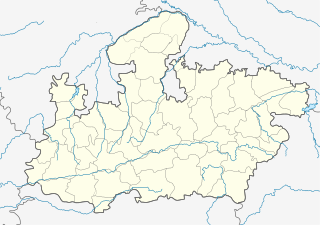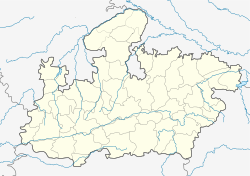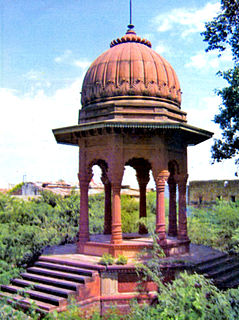| Karwas | |
|---|---|
| village | |
| Coordinates: 26°18′57″N78°32′24″E / 26.31583°N 78.54000°E Coordinates: 26°18′57″N78°32′24″E / 26.31583°N 78.54000°E | |
| Country | |
| State | Madhya Pradesh |
| Languages | |
| • Official | Hindi |
| Time zone | IST (UTC+5:30) |
Karwas is a village in Bhind district in Madhya Pradesh. It was the site of an important fort of Gohad Rana Jat rulers. The ancestor of Bamraulis Jagdeo Singh had come from Agra and stayed at Bhind which was ruled by Aniruddh Singh Bhadauria. There was war between Bamraulias jats and Bhadauria rulers at place called Pach'hara in which Bhadauria was defeated. The Rana Jats kept their capital at Pach'hara for some time and later shifted the capital to Gohad. The brother of Gohad ruler Jagdeo Singh constructed a fort here in samvat 1680 (1623 AD). [1]
Bhind is a city in the Indian state of Madhya Pradesh. It is the headquarters of the Bhind district.

Madhya Pradesh is a state in central India. Its capital is Bhopal, and the largest city is Indore, with Jabalpur, Gwalior, Ujjain and Sagar being the other major cities. Nicknamed the "Heart of India" due to its geographical location, Madhya Pradesh is the second largest Indian state by area and the fifth largest state by population with over 75 million residents. It borders the states of Uttar Pradesh to the northeast, Chhattisgarh to the southeast, Maharashtra to the south, Gujarat to the west, and Rajasthan to the northwest. Its total area is 308,252 km2. Before 2000, when Chhattisgarh was a part of Madhya Pradesh, Madhya Pradesh was the largest state in India and the distance between the two furthest points inside the state, Singoli and Konta, was 1500 km. Konta is presently in Sukma district of Chhattisgarh state.

Gohad is a city and a municipality in Bhind district in the Indian state of Madhya Pradesh. A town of historical importance it is situated close to the city of Gwalior.It is known as Jatwara also.
This place had played an important role in the defeat of Rana rulers of Gohad at Gwalior fort. The chieftain of Karwas fort along with Motumal aligned with Sindia and planned a conspiracy to kill Maharaja Bhim Singh Rana. The Karwas chieftain had demanded a separate free state for him which was refused by Maharaja Bhim Singh Rana. The Gohad ruler got angry over his demand and reduced his status. The Karwas chieftain conspired and signed a secret treaty with Sindia. As an award of which he was made the commander of Maratha army during Panipat war for one day. The Marathas were victorious that day. It was here a strategy was made that Marathas armies would attack Maharaja Bhim Singh Rana from three sides at regular intervals . They first occupied Bilhati fort and the secondly attacked Gwalior fort. The gates were opened from inside and Maharaja was killed by conspiracy of Karwas chieftain. [2]
Scindia was a Hindu Maratha dynasty that ruled the Gwalior State. The Gwalior state was a part of the Maratha Confederacy in the 18th and 19th centuries, and a princely state of the colonial British government during the 19th and the 20th centuries. After India's independence in 1947, the members of the Scindia family became politicians.

The Maratha are an Indian caste, originally of Marathi-speaking peasant-warriors. They established the Maratha Empire in 1674 and were the dominant power on the subcontinent for much of the following century before their downfall in 1818. They were champions of Hinduism in the face of the Islamic Mughal Empire.
At present there are only the ruins of the fort at Karwas. The descendants at present living in Karwas include 8 families of Bamraulia Rana rulers and 5 families of Descendants of Jagdeo Singh. The genealogy of Bamraulia descendants in this village is as under: Aman Singh, his son Acharaj Singh, his son Thakur Das, his son, Tamir Singh, his son Jaswant Singh, His son Ganesh Singh, His son Govind Singh. [2]


